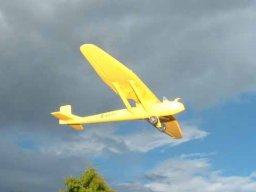BAC (Kronfeld) Drone, Barry Clay
During the early 1930's the British Aircraft Co. of Maidstone built a series of gliders culminating in the B.A.C VII tandem two seater. In 1932 C.H.Lowe Wylde, designer and managing director of the firm, fitted a B.A.C VII BGA.186 with an undercarriage and a 600 c.c Douglas flat-twin motorcycle engine mounted above the wing on a steel pylon. This additional equipment approxmately equalled the weight of the second occupant. The single seat prototype known as the Planette, proved both docile and manoeuvrable with a speed range of 15-20 mph, following this initial success three more were constructed. The aircraft made a number of demonstrations at Hanworth and West Malling during 1933, the designer whilst on one of these demonstration flights took ill in the air and the aircraft sideslipped into the ground and he was killed. The company was then taken over by the Austrian sailplane pilot Robert Kronfeld who carried on with the demonstration flights and acquired premises at Hanworth near London, before the company closed down during 1937 some 33 Drones had been built at the factory.
A remarkable flight was made during 1936 when Col. the Master of Sempill ( later Lord Sempill) made a remarkable flight from Croydon in the UK to Berlin and back on a mere 25 shillings worth of petrol in eleven hours, in the following week the aircraft displayed at Selfridges store in London to publicise the event. Subsequent Drones were fitted with either a 30 hp Carden Ford water cooled engine, or some with a Cherub 3 motor. Although a delight to fly even in poor visability the incredible noise created by the close proximity of the engine propeller tips to the structure would mean that the aircraft could be heard miles away! To try and cure this problem Kronfeld made a conversion whereby the wings were swept back, this brought the propeller some 6 inches aft of the trailing edge. One bizarre use of a Drone was by 609 ( Figther) Squadron on duck-shooting duties using a 12 bore shot gun and a ring and bead sight! Two aircraft were also supplied to India. Although by todays standards the Drone may have seemed a strange aircraft it was, however, a pioneering light aircraft utilising low powered, cheap to run motor cycle engines.
The BAC Drone could be heard for miles away whilst in flight, a strong headwind would mean that the aircraft would literally hover.
Basically a powered sailplane with a pusher engine mounted onto a pylon, the Drone achieved sustained flight on very low powered engines; once more very cheap flying for enthusiasts.
About the model: The model was built entirely from a Panama wooden cigar box by myself some 50 years ago ( yes that is 1956 ! ) the wheels were wartime pot cast items which at that time could still be obtained from model shops, the wood was carved with nothing more than a penknife and glasspaper, the tiny propeller which cannot be seen in the photographs was carved from a matchstick. After a coat of dope and mums best talcum powder she was painted with very early Humbrol enamel.
No restoration has been done on the model she is exactly as built back then.



